Last Chance to Catch NYC's Holiday Notalgia Train
We met the voices of the NYC subway on our nostalgia ride this weekend!


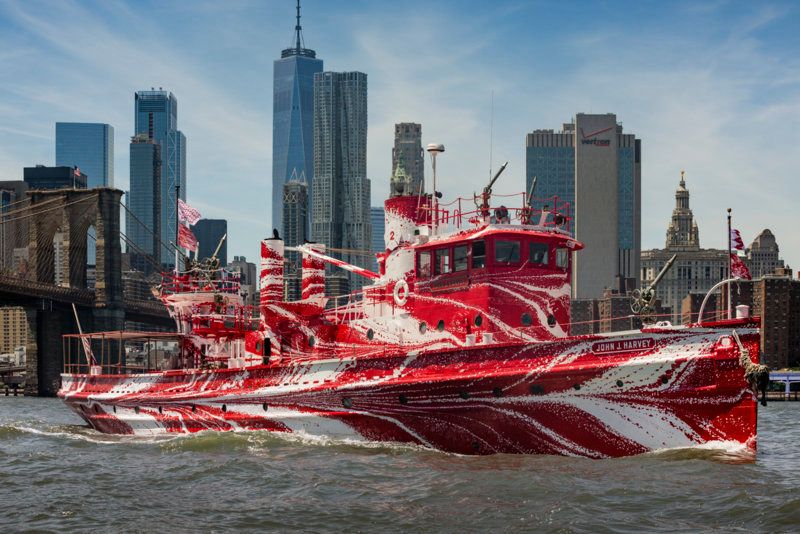 Photo by Nicholas Knight courtesy of Public Art Fund
Photo by Nicholas Knight courtesy of Public Art Fund
Without a doubt, the summer energy in New York is going strong. Beach trips and park picnics abound, even as the temperature climbs and the holiday festivities wind down. Now’s the time to take advantage of all the outdoor culture that the city has to offer, and luckily, this month offers an abundance of outdoor art installations that span across the boroughs in an array of locations. From highly anticipated displays to little-known gems, there’s much to see this month across the five boroughs. Why not pick a few and check them out yourself?
Read on to see our picks for July 2018!
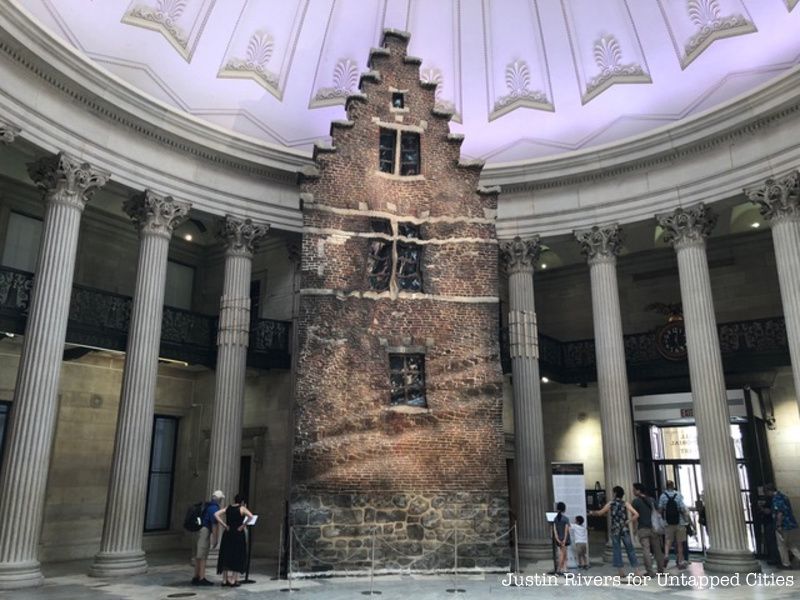
Brian Tolle’s Eureka is a towering 40-foot sculpture inside Federal Hall. This piece pays homage to New York’s Dutch colonial history by featuring a tall brick facade of a canal house in the style that was common in 17th century New York. However, there is a twist: instead of featuring a flat replica of a typical facade, Tolle choose to create one that appears to be rippling and distorted. When asked about this artistic decision, Tolle states that the piece is a nod to New York’s “fluid, but troubled, transformation from a Dutch seat of power to British colony, to an American platform for diversity and democracy.”
Federal Hall serves as a fitting location for this installation in that in the 1700s, the Federal Hall site was used as a city hall, a site where numerous historic events like court cases and political meetings took place. Tolle’s piece is reminiscent of this monumental, turbulent history.
Eureka will be on view until September 8.
To learn more about the Dutch history of New York City grab tickets to our upcoming tour of the Remnants of Dutch New Amsterdam!
Tour of The Remnants of Dutch New Amsterdam
 Photo by Nicholas Knight courtesy of Public Art Fund
Photo by Nicholas Knight courtesy of Public Art Fund
Flow Separation by New York artist Tauba Auerbach is a piece that converts the historic Fireboat John J. Harvey into what the Public Art Fund calls a “contemporary dazzle ship.” The concept of the “dazzle ship” dates back to World War I, when British painter Norman Wilkinson came up with the idea to strategically paint war ships in a way that created optical illusions that distorted the forms of the boats. Thus, they puzzled the soldiers on enemy ships who struggled to track the movements of the British ships.
2018 marks the anniversary of the end of World War I, and Auerbach’s installation prompts us to reflect upon this history. The piece evokes themes of innovation and abstraction, for Auerbach was inspired by the forms of objects as they move through water. She employed the method of transferring ink on water onto paper to achieve the pattern on the display boat.
Flow Separation will be on view through May 12, 2019. Until August 12, 2018, it will be on view at Pier 6 of the Brooklyn Bridge Park. Starting July 14, boat trips will be offered on the weekends; tickets can be purchased on the Public Art Fund website. As part of the festivities for City of Water Day, the boat will be giving free rides! Unfortunately, those rides are already booked but you can keep an eye on the fireboat’s calendar to see when registration for future rides open up.
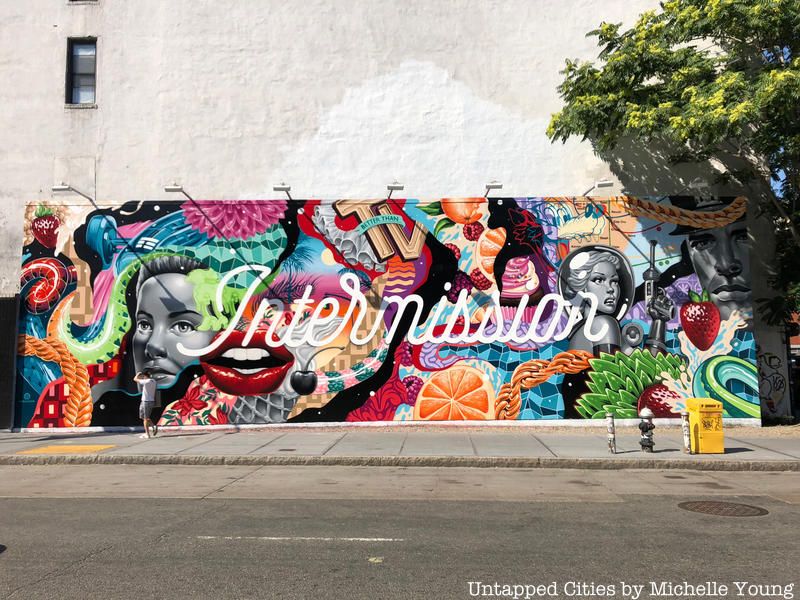
In June 2018, acclaimed street artist Tristan Eaton began work on a mural on the Houston/Bowery Wall, prompting much anticipation for the finished piece. The mural combines images and themes from cinema and pop culture, evoking the nostalgia of the cinematic Manhattan, where beauty and grunge simultaneously existed in the age of matinees and showgirls.
A notable detail of the mural is present in the background details. In the upper right corner of the piece a subway map is depicted in which notable street artists are listed as stops on the map, including Tats Cru, Crash, Futura, Daze and more.

Photo by Pablo Enriquez courtesy of MoMA PS1
Hide and Seek, designed by Jennifer Newsom and Tom Carruthers of Dream the Combine, will be on view in the courtyard of MoMA PS1 through September 3. This piece was the winning project of the 19th edition of the Young Architects Program at MoMA, which presents emerging architects with the challenge of designing an outdoor installation that is not only innovative, but addresses environmental issues.
MoMA describes Hide and Seek as a “responsive, kinetic environment that features eight intersecting elements arrayed across the entirety of the MoMA PS1 courtyard” that is “inspired by the crowd, the street, and the jostle of relationships found in the contemporary city.”

The Garment District’s Urban Garden is an outdoor event/installation in which the two blocks of Broadway between 39th and 41st streets are closed to traffic in June and July in an effort to bring more public and green space, art and culture, and activities to the Garment District. Created by artists Nancy Saleme and Patricia Cazorla, “Ararauna” is a 400 foot art walk that runs down the street itself.
The Urban Garden celebrates the reclaiming of urban space from motorists, as it is blocked off to traffic, and pedestrians and cyclists flood the space. With this transformation of the space comes expanded biking areas, more trees and grass, free fitness classes, and food vendors.

On July 11, Times Square Art, No Longer Empty, and Queens Museum presented the opening of Mel Chin’s Wake sculpture and mixed reality piece Unmoored as part of Mel Chin: All Over the Place, a exhibition of Chin’s work that is located not only in the Queens Museum but all over the city. According to the Queens Museum, Wake “is a presence evoking the hull of a shipwreck crossed with the skeletal remains of a marine mammal bleached by erosion and time.”
Unmoored is a collaboration between Mel Chin and Microsoft that aims to tackle the topic of climate change and prompt discourse on the subject. The piece is a mixed reality installation that “explores a potential future where global warming has gone unchecked”; it uses technology like the Microsoft HoloLens to allow viewers to explore an underwater version of Times Square to prompt participants to grasp the potential reality of climate change.
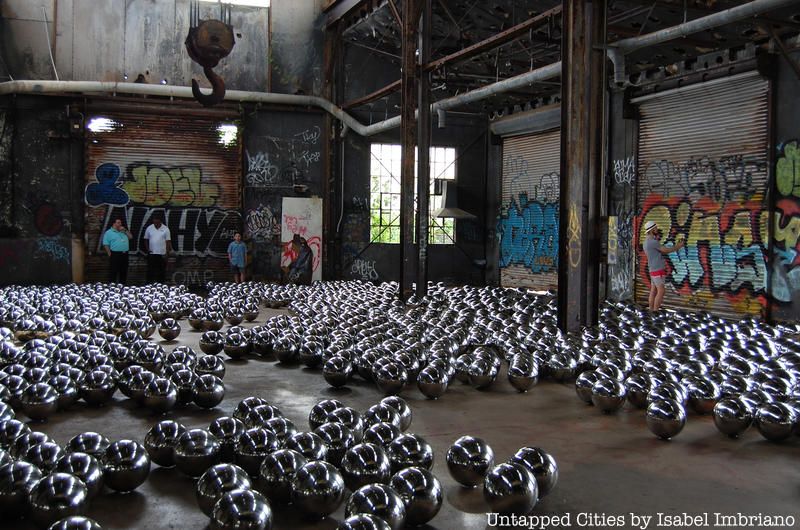
Through September 3, MoMA PS1 is displaying Narcissus Garden by Yayoi Kusama as part of the Rockaway! 2018 public arts festival presented in conjunction with the Rockaway Artists Alliance and Jamaica Bay-Rockaway Parks Conservancy at the Gateway National Recreation Area at Fort Tilden. The piece is situated within a former train garage, a relic from the days in which Fort Tilden served as an active military base.
Kusama’s piece is composed of 1,500 mirrored stainless steel spheres that reflect its abandoned industrial surroundings, simultaneously highlighting the area’s history and the more present and still visible history of the damage from Hurricane Sandy in 2012.

At 85 Broad Street, a building full of historical secrets if you know where to look, is in the midst of installing an impressive piece of artwork on the sidewalks encircling the building in Lower Manhattan. It’s inspired by the 1767 map, “The Plan of the City of New York in North America” made by British military officer Bernard Ratzer from 1766 to 1767. Under this map, our readers may recall, there’s a yellow brick outline that marks the walls of Stadt Huys, the original city hall, one of many signs of Dutch New Amsterdam that still remain.
The map, designed by FXCollaborative and made by Jessup Manufacturing Company is made of a foil-backed proprietary material called Asphalt Art, and laid down piece by piece. Fun things of note on the map besides Stadt Huys and Lovelace Tavern, where you can still see the archaeological excavation of the tavern through glass, are the now-lost Princess Street, the old synagogue (original the old mill of Dutch New Amsterdam, home to the congregation of the Sephardic Jews who arrived in 1654 from Spain and Portugal), and the old slips of Lower Manhattan.
You can discover this and more on our tour of the Remnants of Dutch New Amsterdam!
Tour of The Remnants of Dutch New Amsterdam

Photo by Ka-Man Tse courtesy of Times Square Arts
Alice Dunseath’s You Could Sunbathe in this Storm (Slight Return) is part of Times Square’s Midnight Moment. Each day all month, from 11:57 p.m. to midnight, Dunseath’s display which incorporates video art, animation, and live action, overtakes Times Square.
Times Square Arts states, “The work begins with the dramatic collapse of what could be a child’s architectural construction of three-dimensional plaster objects… [which] become animate, transforming and interacting in playful flirtatious movements… overtaken by intensely chromatic, crystalline formations, evoking vast, otherworldly landscapes.”
 Photo by Alexander Atkins, courtesy of the artist
Photo by Alexander Atkins, courtesy of the artist
On July 9, Tribeca Park unveiled artist Rebecca Manson’s first public sculpture, a monumental public art piece titled Come Closer and the View Gets Wider. The piece consists of thousands of handmade, glazed porcelain parts that are fused together to create a magnificent eight-foot orb.
As the title and the composition of the piece suggests, the perspective at which the piece is viewed impacts the viewer’s perception. Each of the thousands of hand-crafted parts appear rather insignificant on their own and from afar, appear to blend in to the seamless piece. Collectively, the small pieces are crucial to creating the whole piece, which stresses the impact of small things coming together to create something greater.

Image Courtesy of James and Karla Murray
James and Karla Murray’s exhibit Moms-and-Pops of the L.E.S. is park of 10 Uniqlo Park Expressions that are on view across the city. This piece is a pop-up that debuted last month in Seward Park on the Lower East Side. Moms-and-Pops is a life-sized structure that displays four large photographs of mom-and-pop ships that have closed in the Lower East Side, such as Cup & Saucer and Chung’s Candy & Soda Stand.
The installation seeks to highlight the disappearance of small businesses like bodegas, coffee shops, luncheonettes, delis, and newsstands that used to be numerous in the Lower East Side. The artists state that the piece seeks to represent the “small businesses that were common in the Lower East Side and helped bring the community together through people’s daily interactions.”
A combination of metal and wooden materials makes the sculpture weather-proof and capable of lasting the entire year, perhaps a nod to the legacy of these now extinct businesses of the Lower East Side.
Untapped Cities hosted a tour of the installation and neighboring local businesses, led by James & Karla Murray and will be hosting another tour this fall. Join Untapped Cities Insiders for the free tour!
 Photograph courtesy of Design Trust for Public Space
Photograph courtesy of Design Trust for Public Space
Sonic Gates is a public art installation that features a series of eight sound sculptures and murals in Staten Island placed along the waterfront, on Bay Street, and in Tappen Park. The installation is part of a larger project titled Future Culture: Connecting Staten Island’s Waterfront by the Design Trust for Public Space in partnership with Staten Island Arts.
Works include the piece in the photograph above, which was made by Arthur Simms and is on display in the harbor off the Stapleton Esplanade, and a piece by DB Lampman, on display in Tappen Park, which consists of an assemblage of wind chimes that hang over the head of its viewers and encourages them to engage with the piece using senses besides sight.
“The Future Culture pilots will highlight our borough’s rich cultural assets, from the Bay Street commercial corridor bustling with restaurants, stores and art centers, to Parks locations where dynamic community activities are taking place, to the spectacular waterfront, where we are reflecting Staten Island’s deep maritime heritage,” said Elizabeth Bennett, Executive Director at Staten Island Arts.
Akin to the Design Trust for Public Space’s initiatives to reactive underutilized spaces under elevated highways (to be covered later in this article), this initiative looks to “inspire Staten Islanders and visitors to walk the underused pathways and unleash new possibilities for regenerating public spaces as a valuable community asset,” said Susan Chin, Executive Director, Design Trust for Public Space.
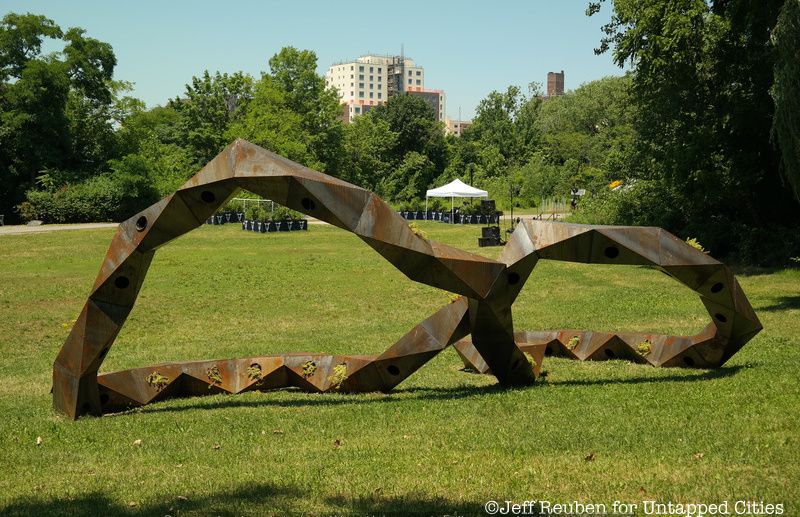
River Rising/Sube el Rio: An Exposition of Science, Art and Technology is an outdoor public art sculpture exhibition in Starlight Park in the Bronx. The exhibit opened on June 30, in a weekend of parades, dancing, and live music to celebrate the revitalization of the Bronx River and Starlight Park.
The installation is composed of eight large-scale public art sculptures by various artists curated by the Bronx River Art Center. The sculptures are meant to be enjoyed as “modern pavilions” that can be utilized as public community spaces. The sculptures pay homage to the 1918 Bronx International Exposition of Science, Arts and Industries.
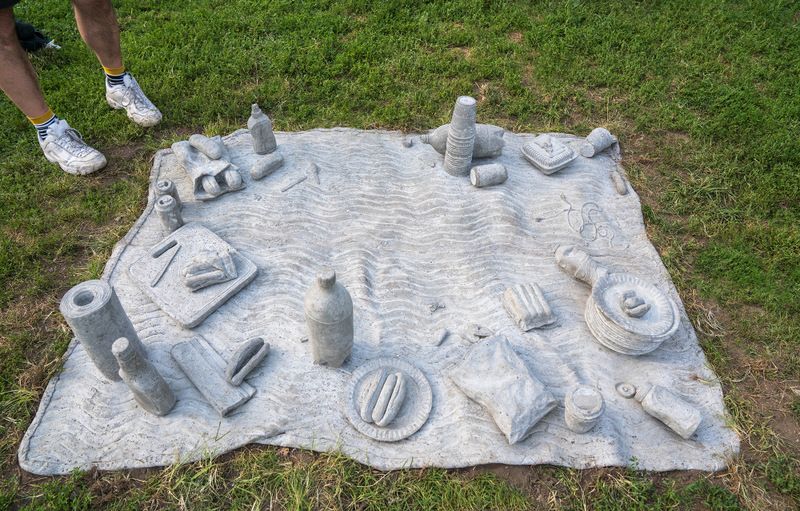
Photo by Tamara Johnson courtesy of NYC Parks
Located in Bushwick’s Maria Hernandez Park, Tamara Johnson‘s Picnic not only depicts a familiar scene, but also evokes common feelings. With the Bushwick community in mind, Johnson aims to capture the experience of having a picnic with friends and family within a public space.
Sponsored by the NYC Parks and Recreation Department, Johnson paid homage to public space by using hand-cast concrete to form typical picnic objects. Johnson describes her work as “turning a temporary happening into a static monument for participation and contemplation.”

Photo by Adam Reich courtesy of the artist and Susan Inglett Gallery
Maren Hassinger: Monuments is an installation in Marcus Garvey Park and sponsored by the Studio Museum in Harlem that runs from June 2018 to July 10, 2019. The exhibition features eight site-specific sculptures by artist Maren Hassinger who used branches to create sculptural forms that evoke aspects of the park landscape, like an oval near the pool, for instance.
Because she is a Harlem-based artist, Hassinger has been associated since the Studio Museum since the 1980s. With Monuments, she took great care to make it “a project made in Harlem and for Harlem.” Specifically, she created the works with volunteers from the Studio Museum’s Teen Leadership Council and the Expanding the Walls program.
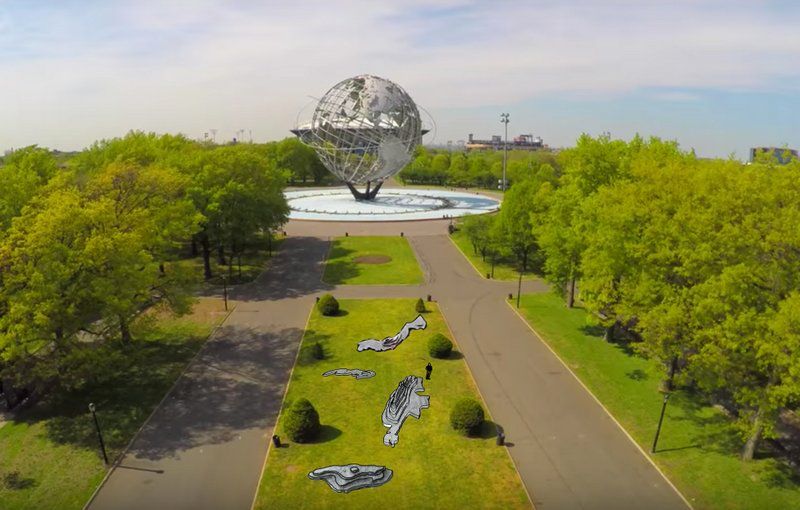

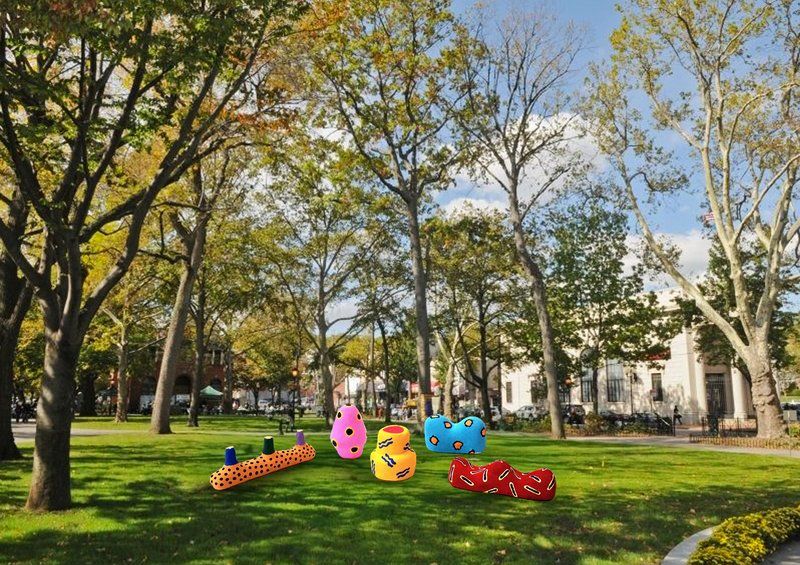
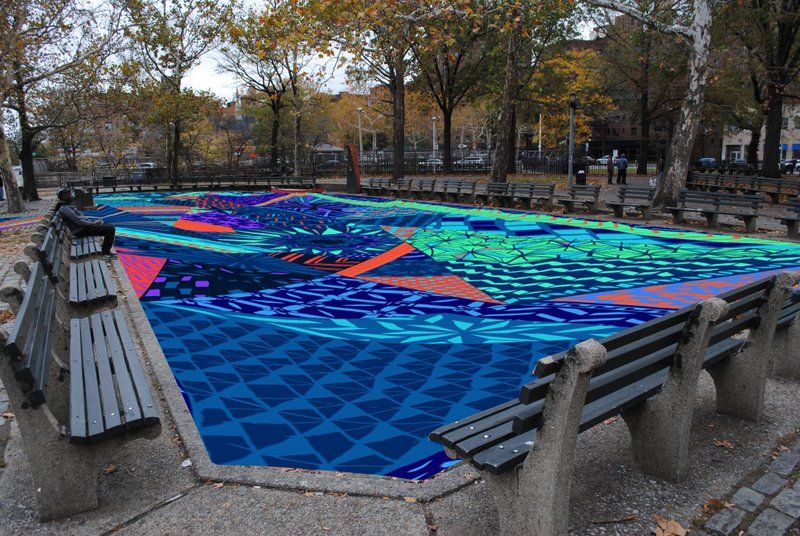

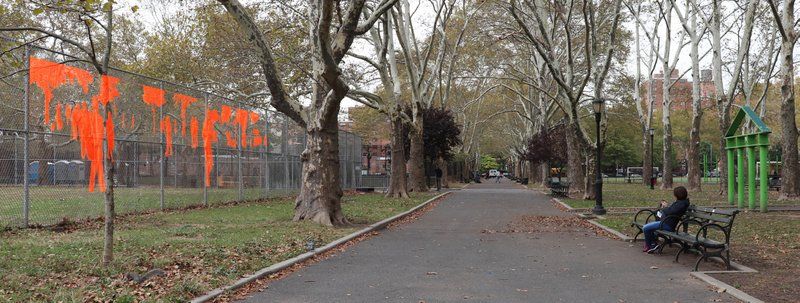
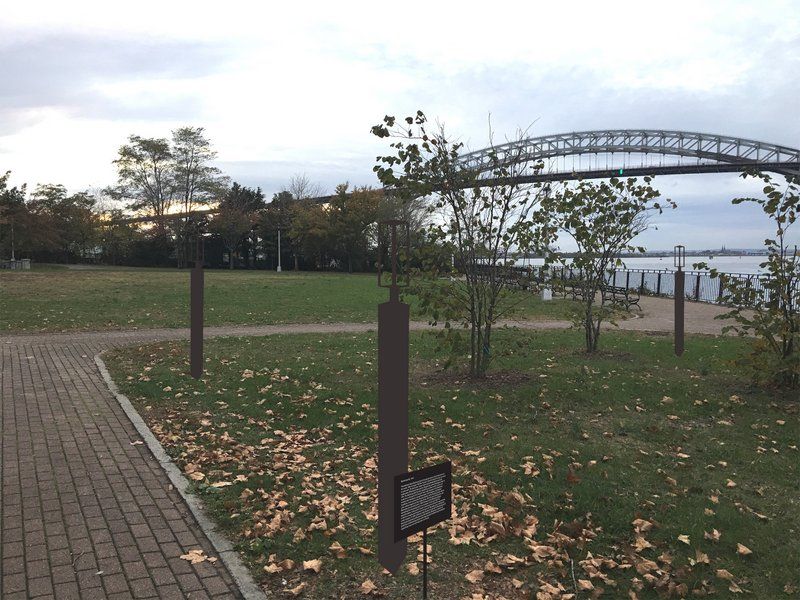


The aforementioned “Moms-and-Pops of the L.E.S” is part of the Uniqlo Park Expressions grant, where each borough of New York City will get two site-specific art installations by emerging artists. The program is a result of NYC Parks’ ongoing initiatives to bring greater equity to parks via cultural programming. While “Moms-and-Pops” is notable, the other installations are quite impressive.
The second Manhattan installation is by Harumi Ori, who will use industrial mesh in the sacred orange color of Japan to make three-dimensional pieces in Thomas Jefferson Park at 113th Street and 1st Avenue.
The Bronx will get works in Joyce Kilmer Park by Dionisio Cortes Ortega (with seating inspired by neighboring Bronx County Courthouse) and in Virginia Park by Cara Lynch (with a colorful ground mural in a play on parquet flooring).
Brooklyn’s Fort Greene Park will have a work by Tanda Francis that explores African presence in public parks and Herbert von King Park in Bedford-Stuyvesant will have by Robert Visani that is inspired by indigenous figures in West African art.
In Queens, Zaq Landsberg will recreate islands from the Unisphere at Flushing Meadows-Corona Park and place them in parts of the park as seating, stages, and meeting places. In Rufus King Park in Jamaica, Mirrored Monuments by Rose Desiano will look at the complex history of displacement and immigration in the neighborhood.
In Staten Island, Jackie Mock will install handmade vitrines that contain antique pencils and writing instruments, a reference to the Eberhard Faber Pencil Company, whose founder Johann Eberhard Faber once had a mansion on the site of Faber Park. And in Tappen Park, Stick Stump & The Lawn Lumps by Adam Frezza and Terri Chiao will feature five colorful sculptures that can be used for a multiplicity of purposes, from seating to performance, relaxation or public interaction.

Photo by Weronika Kwiatkowska courtesy of Ziemia
Ziemia: Our Stories Are Written in Soil is an installation in McGolrick Park in the Greenpoint neighborhood of Brooklyn. Created by Martynka Wawrzyniak with the Polish Cultural Institute, the piece evokes themes of nature, place-based identity, and community.
Ziemia was constructed as part of a community effort: the clay from which the piece was constructed was excavated in Greenpoint and the soil upon which it rests was collected from participating residents from places in which they culturally identify. Many Polish families have lived in Greenpoint for generations, and thus, Kwiatkowska travelled to Poland to collect soil for her own piece. The public location of the piece encourages individuals of different identities to exchange dialogue as the neighborhood undergoes change.
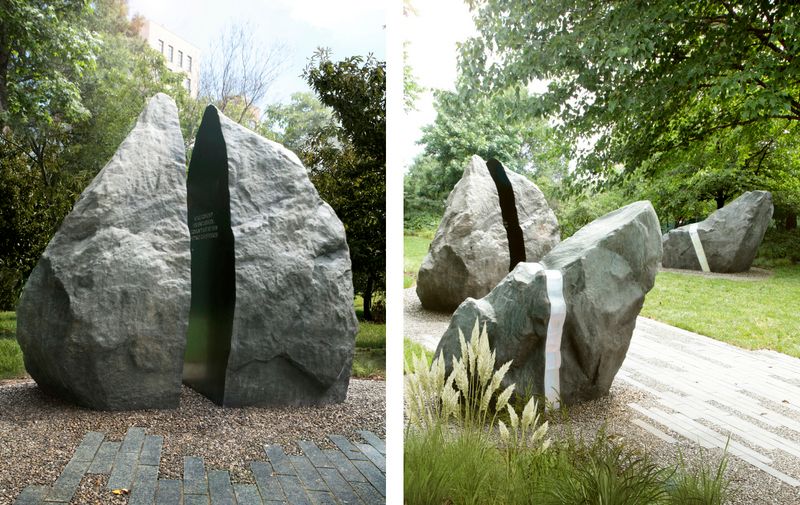
Photo by Anthony Goicolea
On June 24, artist Anthony Goicolea opened the New York City’s first LGBTQ memorial in Hudson River Park. The work is composed of large pieces of glass embedded into steel boulders within the green landscape of the park.
After the Pulse nightclub shooting in 2016, Governor Cuomo created a commission that would be responsible for the installation of a memorial to honor the victims, as well as highlight the role of New York in LGBTQ history and the city’s commitment to its LGBTQ residents. The glass panels in the installation interact with light to emit a faint rainbow glow to pay homage to an iconic symbol of the LGBTQ community.

Photo by Lindsey Hadlock courtesy of Cornell University
Oculi, the winning piece of the 2018 City of Dreams competition, was unveiled on Governor’s Island on June 23 and will be on view through the fall. The City of Dreams competition encourages architects and designers to turn their visions and creativity towards sustainability and ponder environmental problems such as the depletion of resources.
The piece is constructed of discarded grain silos that are elevated to create a variety of shadow patterns, creating an art piece while evoking the imagery of New York’s industrial age. Sustainability is not just present in the construction of the piece, but also in its demolition, in which the the silos are projected to be repurposed for components of experimental housing.
 Photo by Daniel Levin courtesy Domino Park
Photo by Daniel Levin courtesy Domino Park
Domino Park opened on June 10th to the public and one of the highlights is the Artifact Walk, which features over 30 large-scale, hand-picked pieces of salvaged factory machinery from the Domino factory complex that are now placed along the waterfront. The walk “acts as a threshold and entrance. It’s a gesture to get people to inquire about the history of the place,” says landscape architect Lisa Switkin of James Corner Field Operations.
Starting from the south side of the park, a bucket conveyer will greet visitors, followed by four blue syrup tanks with a rusting patina, then a series of screw convertors which shown abstractly look like a public art installation, mooring bollards and finally two teal cranes which rise above the elevated catwalk.
On opening day, Untapped Cities ran the official tour of Domino Park, an experience produced in partnership with Two Trees, the developer of the former Domino Sugar Factory site, with insider information from the landscape architects and artists who worked on the park. We will host the tour again on July 15th:

Never Comes Tomorrow by Jacob Hashimoto in the Liggett Hall archway
In June, Governors Island unveiled two impressive site specific art installations, both by Jacob Hashimoto. In the archway of Liggett Hall (a former Army barracks building that is the size of the Chrysler Building on its side), is an installation made of hundreds of wooden cubes and enormous steel funnels. The work, entitled Never Comes Tomorrow is meant as a threshold that connects Governors Island’s Historic District and the new parks, which include The Hills.
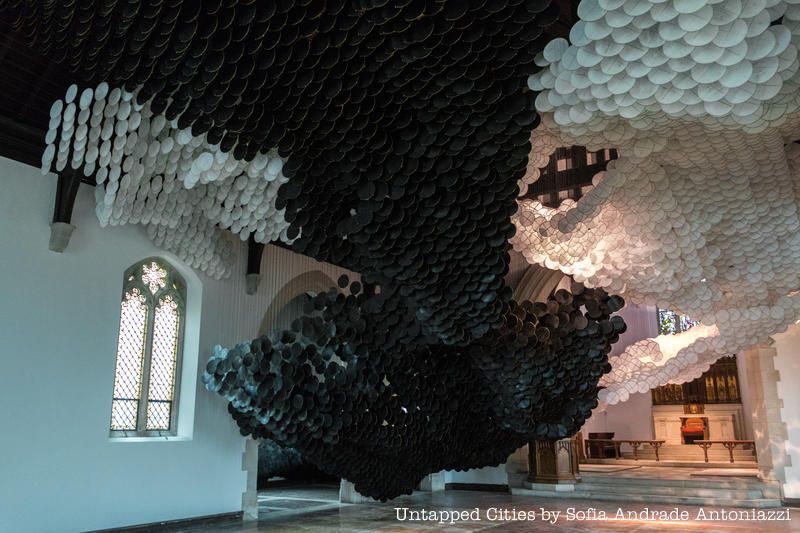
Eclipse, also by Jacob Hashimoto in the St. Cornelius Chapel on Governors Island
Another work by Hashimoto, Eclipse, is located in the St. Cornelius Chapel, featuring thousands of rice paper kites that adapt to the architecture of the historic space, while obscuring the elements. Eclipse was originally installed at the 57th Venice Architecture Biennale at the Palazzo Flangini.
The two installations will be viewable until October 31st this year.
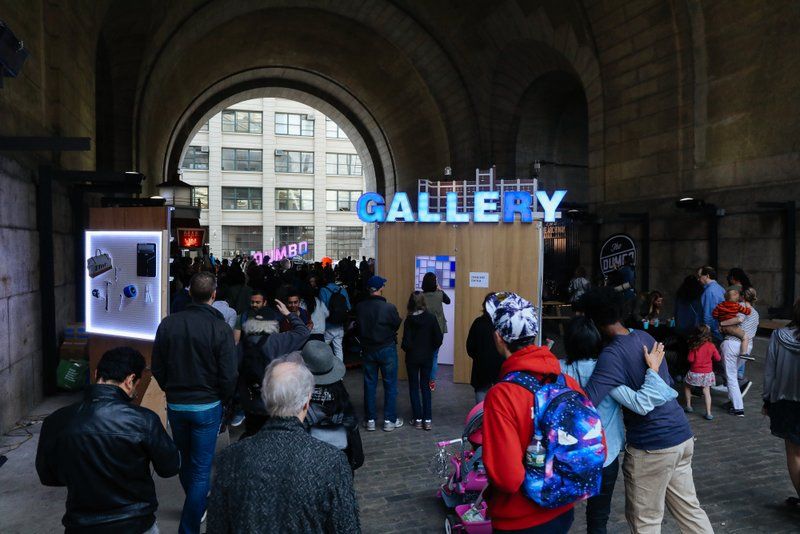
Photo by Stephen Yang courtesy DUMBO BID
Live at the Archway is an annual summer art and music series that takes place weekly. As a part of the event, a flat pack, modular pop-up gallery will be situated under the archway that is a 32-foot replica of the DUMBO gallery This Friday or Next Friday. Each week, a different Brooklyn artist is featured at In the Gallery, “a twofold art experience that jointly exhibits an artist’s work in a small pop-up gallery, and also includes an opportunity for audience members to directly engage with the artist and create a new collaborative piece each week.”
July’s artists include The Blue Vipers, Brown Rice Family, Michael Blume, and Rising Choreographers.

Erwin Wurm’s Hot Dog Bus is the first of three works from Public Art Fund this summer, which was followed by Flow Separation (featured earlier in this article). The bus, which will travel up and down the Brooklyn Bridge Park‘s waterfront, is a vintage Volkswagen Microbus transformed into a bright yellow food truck that will actually be serving hot dogs. All fun aside, Hot Dog Bus is intended to also question capitalistic consumption, from the bloated size of the bus itself to the “additive sculptural process of eating itself,” according to Wurm. Hot Dog Bus is a reimagining of the artist’s “Fat Car” series specifically for New York (which took form as the “Curry Bus” in Austria).
Hot Dog Bus will run through August 26th.

Three-dimensional piece by John Ahearn at Coney Island Art Walls
The Coney Island Art Walls are back for the third year, having reopened for Memorial Day Weekend featuring 41 pieces. The walls are located in what was previously an empty lot along Coney Island‘s main drag. The project is sponsored by developer Thor Equities and curated by Joseph J. Sitt and Jeffrey Deitch.
You’ll find works by street artists like Daze, Icy & Sot, Tats Cru, Nychos, Stephen (ESPO) Powers, Lady Pink, Aiko, Haze, Buff Monster, Sheryo & The Yok, IRAK, Lee Quinones and more.

Photo by Tim Williams, courtesy of Pliskin Architecture
The Manhattan Park Pool, a summer highlight each year, is an 8,000 square foot immersive mural painted around the pool at a rental complex on Roosevelt Island. The annually changing mural is part of the design by K&Co and Pliskin Architecture, using a similar color palette but with different artists each year. This year’s work is by Technodrome1, using a design he transformed from a 2 inch computer doodle into the full installation, color by color, across about a week of painting. The pool opened Memorial Day weekend.
Previous year’s artists include HOT TEA, who painted the inaugural 2015 year pool and Gregg Emery last year.

Along Manhattan’s East Side, a 30 foot Dalmatian puppy is balancing a New York City yellow cab on its nose. This new permanent sculpture, “Spot” by artist Daniel Lipski will be fully unveiled this summer as the public art of a new building, the Helen L. and Martin S. Kimmel Building, part of NYU Langone at 34th Street and First Avenue. In the meantime, you can catch it rising above construction barriers.
As reported by amNEWYORK, the cab is an actual Prius yellow cab, donated by Toyota, and although it does not have a motor, the windshield wipers will work when it’s raining. The female puppy dog is made of fiberglass and steel. Lipski is known for his playful, oversized sculpture installations that often play on iconic objects.

MINI and United Visual Artists, a firm based in London, have installed Spirit of the City at A/D/O, the Greenpoint creative space. Nine-foot high golden, mirrored rectangular columns, intended to evoke the skyscrapers of Manhattan and Brooklyn waterfront, will rotate. The cubes will be illuminated at night.
You can see it as part of Greenpoint Open Studios on June 3rd, or anytime until September 3rd.

During NYCxDesign Week, we were honored to be a partner of The Design Trust for Public Space in the launch of El-Space, a long-term pilot installation located under the Gowanus Expressway in Sunset Park at 36th Street and 3rd Avenue, just adjacent to Industry City. El Space is the product of a five year, critical exploration in how New York City can better activate the forgotten, unfriendly spaces beneath aging elevated infrastructure and culminates in this first pilot installation that showcases what an alternative walkway beneath the Gowanus Expressway could look like.
El-Space was designed with input from the diverse local community through charettes and on-site pop-up workshops, including work with students at Sunset Park High School and members of a Community Advisory Board.The design tests strategies for lighting, green infrastructure, and urban design for replicability, aesthetics, and of course, how the public uses and engages with it. El-Space will be installed for about a year, used to test and refine strategies for future permanent activations. For the passerby, it’s a cool visual addition to an industrial space and for the community, it has created a new meeting spot.

Phyllida Barlow’s prop. Photo courtesy the High Line
In addition to the Agora commissions we featured the last few months, the High Line launched two new installations at the end of May. Kerry Tribe’s Exquisite Corpse is a film that follows the entire 51-mile length of the Los Angeles River chronicling “the river’s neighbors—animal, human, and vegetal—and their stories with one minute devoted to each mile,” according to High Line Art. The film plays daily on The High Line at 14th Street at dusk from May 14 to July 18, 2018.
Then, Phyllida Barlow’s prop is a teetering concrete sculpture, reimagined from a work displayed at the 2017 Venice Biennale, and the first work to be displayed on the Northern Spur Preserve of the High Line at 16th Street, a section that once connected directly to a refrigerated warehouse that was part of the Nabisco cookie factory. Prop will be on view until March 2019.

Virginia Overton; ‘Untitled (Gem);’ 2018; Courtesy the Artist, Socrates Sculpture Park, Bortolami Gallery, and White Cube; Photo by Nicholas Knight.
Socrates Sculpture Park has a park-wide installation, “Built,” all by one artist, Virginia Overton. The works, which include a crystal shaped sculpture of industrial architectural support systems, a 1990 Ford F250 pickup truck, a water feature and aquatic garden in the bed of Dodge Ram, explore the repurposing of industrial objects within a former industrial site, the park itself on the Long Island City waterfront.
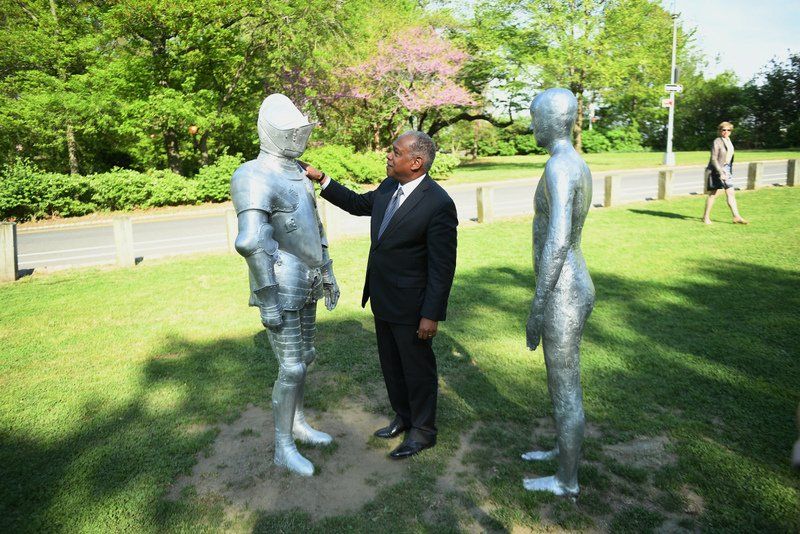
NYC Parks Commissioner Mitchell Silver with the ARMORS. Photo by Malcolm Pinckney via NYC Parks
Icelandic artist Steinunn Thorarinsdotti has created ARMORS, a site-specific installation for the Cloisters Lawn in Fort Tryon Park, featuring suits of armor cast from 3D scans of armors in the Metropolitan Museum of Art permanent collection. The three casts sit “in dialogue” with one another, according to the Fort Tryon Park Trust website, which has a description of the artist and her work:
“The project’s incorporation of armor—a form that is both distinctly iconographic and foreign to the artist’s own hand—marks an aesthetic and conceptual divergence for Icelandic Thorarinsdottir, who in her home country is a celebrated pioneer (the first female sculptor to have two solo shows at the Reykjavik Art Museum, 1982 and 1987) whose androgynous figure installations have since 1976 been mounted in dozens of prominent sites around Reykjavik and beyond.”
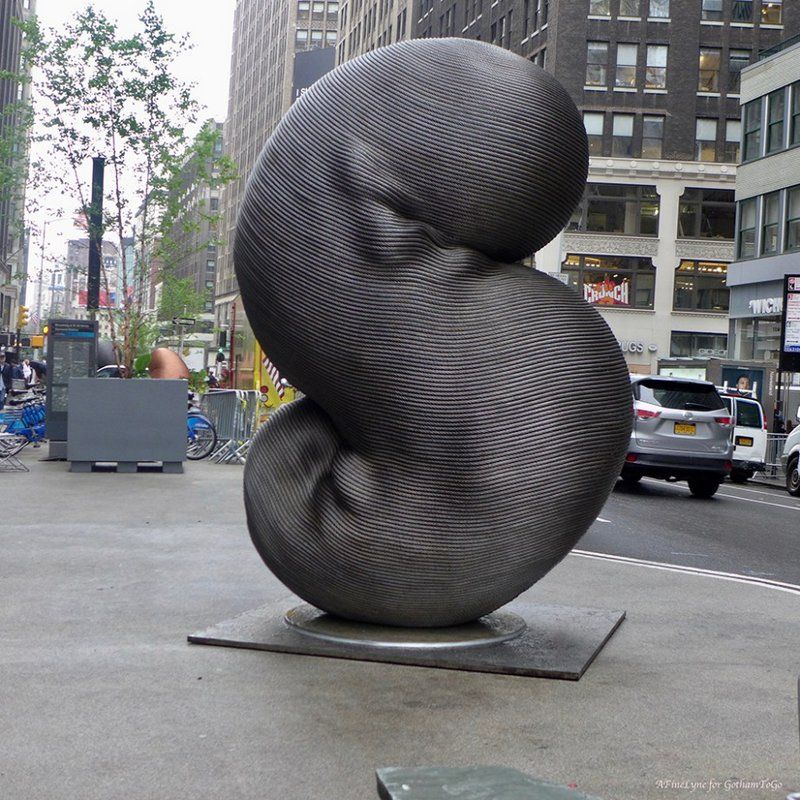 Photo by Lynn Lieberman/Gotham to Go
Photo by Lynn Lieberman/Gotham to Go
The Garment District Alliance and NYC DOT’s Arterventions has brought seven of Taiwanese artist Kang Muxiang’s large works to the Garment District Plazas between 36th Street and 38th Street. The sculptures in the series Rebirth are made from discarded steel cables from Taipei 101, Taiwan’s tallest skyscraper and the world’s tallest building from 2004 to 2010. The largest sculpture is over 10 feet tall and 3,500 pounds in weight. You can read more about each sculpture on the Garment District Alliance website.
This is the second Taiwanese artist to grace the malls of the Garment District, with Hung Yin’s A Fancy Carnival in 2016.
 Image by Hyla Skopitz courtesy The Metropolitan Museum of Art
Image by Hyla Skopitz courtesy The Metropolitan Museum of Art
The Metropolitan Museum of Art’s rooftop site specific installation, titled We Come In Peace, is now on view to the public until October. Created by Pakistani artist Huma Bhabha, this rooftop installation is The Met’s sixth in a series of site specific commissions for the outdoor roof space. The sculptures consist of the 12-foot-tall five-headed intersex figure “We Come in Peace,” and the 18-foot-long prostrate Benaam — an Urdu word that translates to “without name.”
We Come in Peace borrows its title from the classic American science-fiction film The Day The Earth Stood Still (1951)

, a tale of first contact between humans and aliens. The sculptures are cast in bronze, but were initially handcrafted to scale by Bhabha using ephemeral materials, such as cork, Styrofoam, air-dried clay, and plastic.
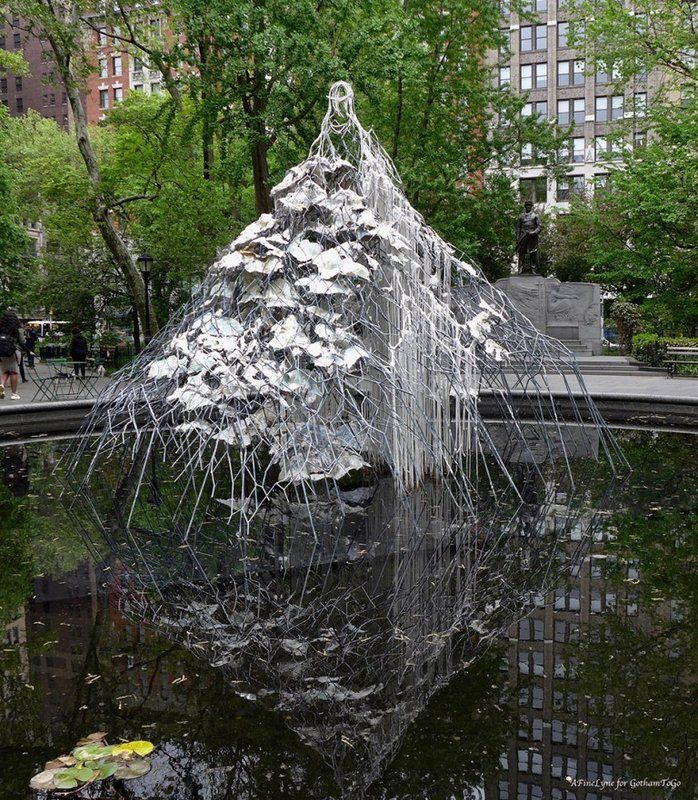
Photo by Lynn Lieberman/Gotham to Go
On view until September 3rd, Madison Square Park will welcome a new public art exhibition, Delirious Matter, by Brooklyn-based artist Diana Al-Hadid. Delirious Matter is Al-Hadid’s first major public art project, and The Madison Square Park Conservancy’s thirty-sixth exhibition, which will feature six new sculptures to be installed across the park’s central Oval Lawn, peripheral lawns and northern reflecting pool.
The Madison Square Park Conservancy notes that Al-Hadid’s integration of sculpture with plant material is a first for the program. The walls, which deceivingly appear fragile, will stand in direct contrast to the concrete and steel skyscrapers surrounding the park. For more on the project, visit madisonsquarepark.org, and join the conversation via social media by using the hashtags #MadSqArt, #DianaAlHadid, and #MadSqDeliriousMatter.
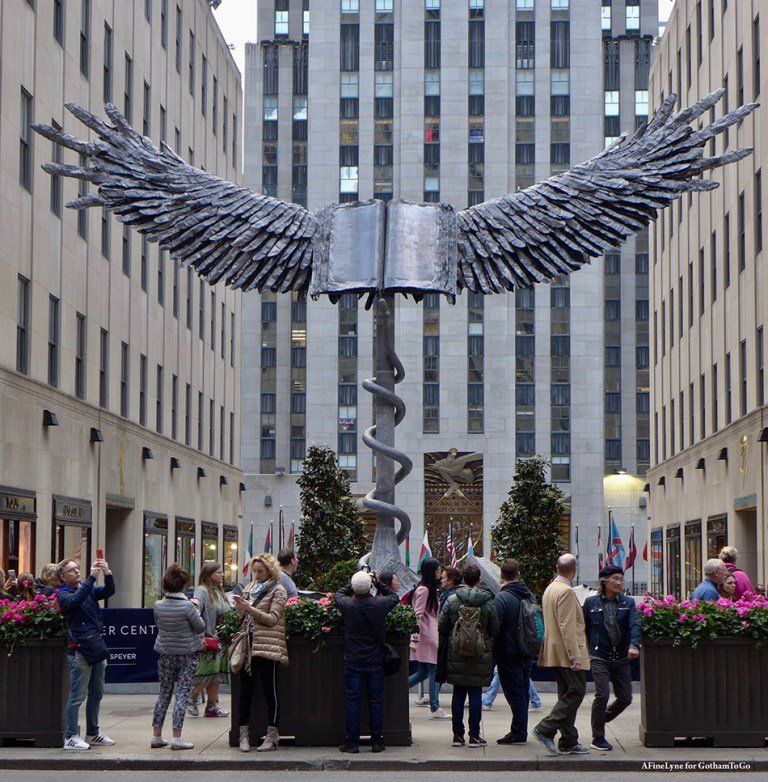
Photo by Lynn Lieberman/Gotham to Go
Until July 22nd, 2018, a winged sculpture can be found above Rockefeller Center’s Channel Gardens, between 49th and 50th Streets in Midtown Manhattan, facing Fifth Avenue. It’s the first site-specific outdoor public sculpture from prominent German artist Anselm Kiefer ever to be commissioned for the United States. Titled Uraeus, the work consists of a gigantic open book with eagle’s wings, spanning 30 feet and made of lead, sitting on top of a 20-foot-tall lead-clad stainless steel column.
The column’s base will feature giant lead books, while a large snake coils up its length. The sculpture’s title, Uraeus, refers to the erect shape of the Egyptian cobra, associated with the serpent goddess Wadjet and a symbol of power and divine authority. For more, check out Public Art Fund’s write up on the sculpture.
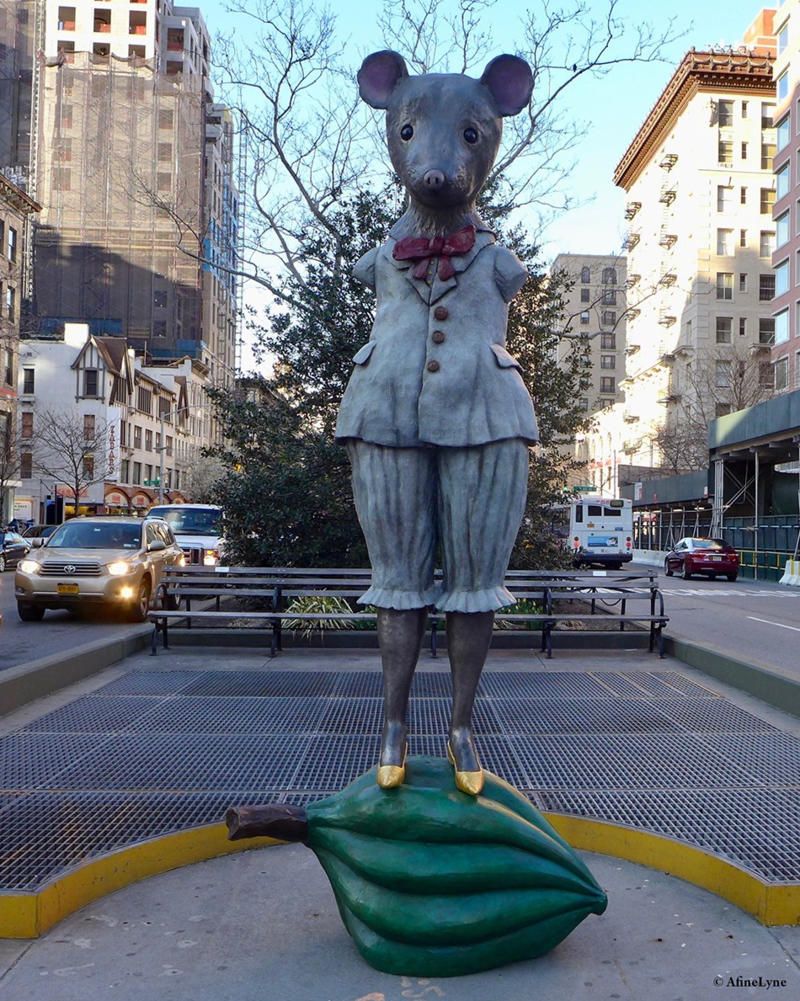
Photo by Lynn Lieberman/Gotham to Go
The Broadway Mall Association debuted Kathy Ruttenberg on Broadway: In Dreams Awake. The exhibit includes six works featured on the Broadway center mediums, located on 64th, 72nd, 79th, 96th, 116th, and 157th Streets.
Each sculpture — described as a combination of human, animal and plant forms — is made from cast silicon bronze, and range between 6 feet to 15 feet in height. (Some even feature LED lighting!) The exhibit will be on view through February 2019.
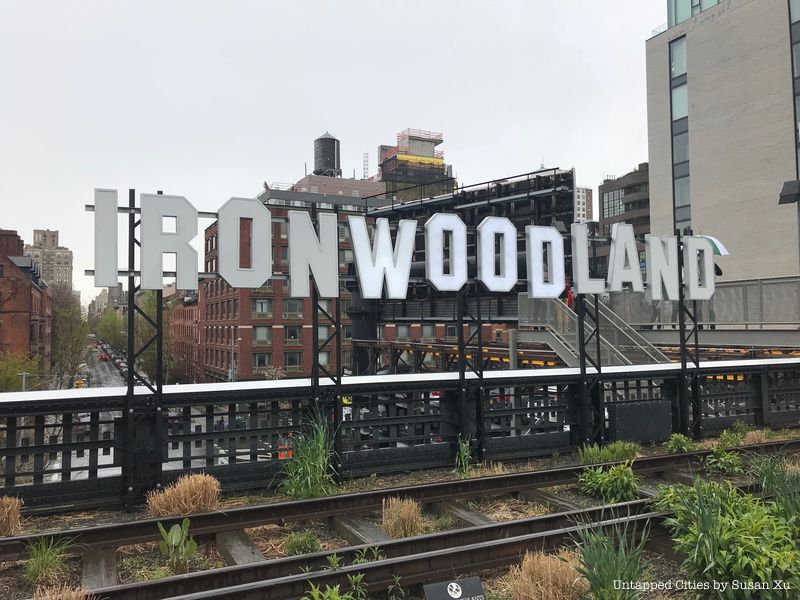
AGORA on The High Line is an outdoor group exhibition by nine artists explores the role of art and artists in defining, creating, and using public space. The name of the exhibit is inspired by the same ancient Greek word, which literally translates to a gathering place — a fitting name as New York City’s public spaces have served as a home to a plethora of artworks over the decades, ranging from WPA murals to graffiti tags.
AGORA will focus on the power of art to change society. As such, it addresses current issues, including women’s rights, mass incarceration, the environment and immigration. For instance, the work above, “C.R.E.A.M.,” by Sable Elyse Smith, is an altered replica of the Hollywood Sign that reads IRONWOODLAND — a reference both to the Ironwood State Prison and to “Hollywoodland,” the segregated real estate development that was advertised by the original sign. The exhibit will be on view until March 2019 at various locations along The High Line.
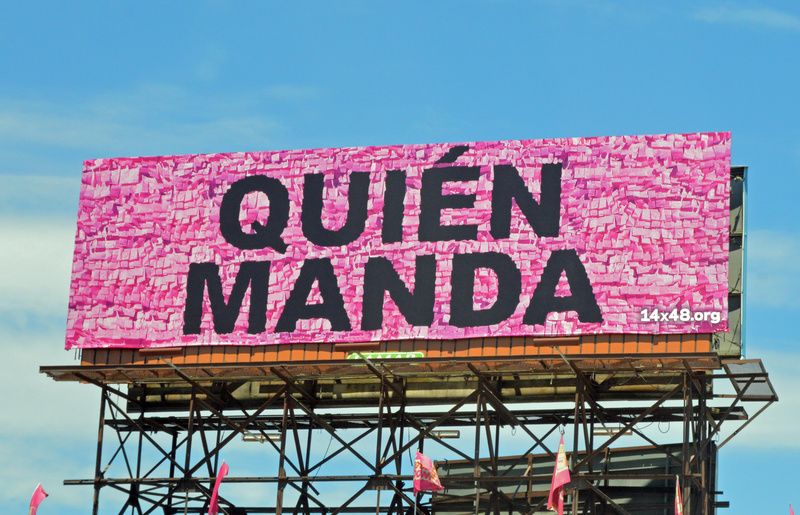 Image Courtesy of Giovanni Valderas
Image Courtesy of Giovanni Valderas
Artist Giovanni Valderas designed a giant billboard that reads QUIÉN MANDA against the backdrop of a piñata for, 14×48, a non-profit arts organization that posts public art in the New York City area. It was installed in June on the Grand Concourse in the Bronx at E. 149th Street.
QUIÉN MANDA, a Spanish idiom which most precisely translates to “Who rules?” poses an emboldened question of agency. Giovanni Valderas’ body of work, which began in Latinx neighborhoods in Dallas, Texas, focuses on engaging with the Latinx community (many of whom are not familiar with contemporary art) through guerrilla and public installations and incorporates Spanglish idioms often used in Chicano/Latinx communities.

Vesey mural by Chinon Maria and Sebastian Mitre
While construction of 2 World Trade is on hold, a collection of corrugated metal sheds housing mechanical equipment have been spruced up by artists from around the world to make the area look less like a construction zone and more like a hip pedestrian throughway. The sheds, which are bounded by Greenwich, Vesey and Church Streets and the Oculus transportation hub, feature murals by Australian illustrator Brolga, Los Angeles-based artist Todd Gray, Korean-born Joohee Park, aka Stickymonger, the husband and wife team of Chinon Maria and Sebastian Mitre, Japanese-born, New York resident Riiisa Boogie, and Bronx native Hektad. When all of the murals are complete there will be 8 colorful works to see!

Mural by Todd Gray
Join our walking tour of the new Domino Park!
Subscribe to our newsletter